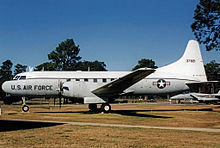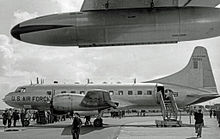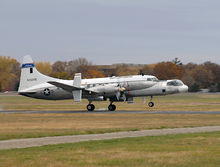- Convair C-131 Samaritan
-
C-131 Samaritan
R4Y / T-29Convair C-131D Samaritan Role Military transport Manufacturer Convair First flight 1949 Introduction 1950 Retired 1990 Primary users United States Air Force
United States Navy
Paraguayan Air ForceDeveloped from Convair CV-240 family The Convair C-131 Samaritan was an American military transport produced from 1954 to 1956. It is the military version of the Convair CV-240.
Contents
Design and development
The design began life in a production requirement by American Airlines for a pressurized airliner to replace the classic Douglas DC-3. Convair's original design had two engines and 40 seats, and thus it was designated the CV-240. The first CV-240 flew on March 16, 1947, and production aircraft were first delivered to American on February 28, 1948. Seventy-five were delivered to American, with another fifty going to Western Airlines, Continental Airlines, Pan American Airways, KLM, Sabena, Swissair and Trans Australia Airlines.
Operational history
 Convair C-131B of the U.S. Air Force at Eglin AFB Florida
Convair C-131B of the U.S. Air Force at Eglin AFB Florida
The CV-240/340/440 series was used by the United States Air Force (USAF) for medical evacuation and VIP transport and was designated as C-131 Samaritan. The first model Samaritan, the C-131A, was derived from the CV-240 model, and was delivered to the USAF in 1954.
The earlier trainer model, designated the T-29, was also based on the Convair 240 and was used to instruct USAF navigators for all USAF aircraft and those USN Naval Flight Officers (NFOs) selected to fly land-based naval aircraft. First deliveries to the USAF were made in 1950 followed by large production quantities until early 1955. The USAF and the USN operated T-29s in separate units at separate locations until 1976. In 1974, the USAF T-29s with the 323d Flying Training Wing (323 FTW) at Mather AFB, California began to be replaced by the Boeing 737-derived T-43. In 1975, the Navy retired all of its T-29s assigned to Training Squadron Twenty-nine (VT-29) at NAS Corpus Christi, Texas, deactivated VT-29, and merged their advanced navigator training program for land-based NFOs with the Air Force's program at Mather AFB.
A planned bomber training version of the T-29 (designated T-32) was never built. The CV-340 model was used for most C-131Ds.
The United States Navy used the Samaritan, initially designated as the R4Y until 1962, at which point the naval aircraft were also redesignated as C-131s. Nearly all of the C-131s left the active inventory in the late 1970s, but the U.S. Coast Guard operated the aircraft until 1983, while the Air National Guard and Navy units operated additional airframes, primarily as Operational Support Aircraft (OSA) for Air National Guard flying wings and as naval air station aircraft until 1990. The C-131 was primarily replaced by the C-9 Nightingale in Regular USAF service, with the Air National Guard replacing their OSA with C-130 Hercules aircraft and the Navy with C-12 Hurons.
A Samaritan was the first aircraft used as a flying gunship testbed in mid-1963, in a program known as "Project Tailchaser".[1] A C-131B (AF Ser. No. 53-7820) was given a gunsight for the side window, but instead of guns it had cameras in the cargo area. Eventually the C-131 was ferried to Eglin AFB in Florida and a General Electric SUU-11A/A 7.62 mm Gatling-style Minigun was installed. Live ammunition was used and both over-water and over-land tests were successful.
Accidents and incidents
On 17 December 1960, a Samaritan crashed at Munich in what is the largest loss of life in an accident in the Bavarian capital. Shortly after takeoff one engine failed and the pilot tried to get back to Riem in heavy fog over Munich. Due to the limited visibility the aircraft struck the tip of St. Paul's church close to the Theresienwiese, and crashed onto a streetcar, killing all 20 people on board the plane, and 32 on the tram.[2]
Variants
 An ex-Navy T-29B Flying Classroom on display at the Pima Air & Space Museum
An ex-Navy T-29B Flying Classroom on display at the Pima Air & Space Museum
- C-131A
- United States Air Force version of the Model 240 with seats for 37 passengers, 26 built.
- HC-131A
- Surplus C-131As transferred to the United States Coast Guard, 22 transferred.
- MC-131A
- Temporary designation used before 1962 when a C-131A was used for medivac duties with 27 stretchers.
- VC-131A
- Temporary designation used before 1962 when a C-131A was used as a staff transport.
- C-131B
- A hybrid Model 240/340 with seats for 48 passengers, 36 built.
- JC-131B
- C-131B converted for missile tracking, six conversions.
- NC-131B
- One C-131B used for permanent testing.
- VC-131B
- C-131B when used as a staff transport.
- YC-131C
- Two Model 340s flown with Alison 501D-13 engines.
- C-131D
- Military version of the Model 340 with seats for 44 passengers, 33 built.
- VC-131D
- C-131D when used as a staff transport.
- C-131E
- Electronic Countermeasures training version for Strategic Air Command (SAC), later designated TC-131E, 15 built and one conversion from C-131D, two transferred to United States Navy as R4Y-2.
- TC-131E
- C-131E redesignated.
- C-131F
- R4Y-1 redesignated.
- RC-131F
- Conversions for photo-mapping and survey, six conversions.
- VC-131F
- R4Y-1Z redesignated.
- C-131G
- R4Y-2 redesignated.
- EC-131G
- One C-131G modified as an electronics trainer.
- RC-131G
- One C-131G modified as an airways aid checking duties.
- VC-131G
- C-131G used as a staff transport.
- C-131H
- Other models converted to Model 580 turboprop standards.
- NC-131H
- One conversion with an extended nose incorporating a separate cockpit as a Total In-Flight Simulator. This aircraft was transferred to the National Museum of the United States Air Force at Wright-Patterson AFB, Ohio on November 7, 2008[3]
- R4Y-1
- United States Navy version of the Model 340 with 44 passenger seats, redesignated C-131F in 1962, 36 built.
- R4Y-1Z
- United States Navy staff transports, redesignated VC-131F in 1962, one built and conversions from R4Y-1.
- R4Y-2
- Two C-131Es transferred to the United States Navy, redesignated C-131G in 1962, an additional 13 cancelled.
- R4Y-2Q
- Projected radar countermeasures version of the R4Y-2, five cancelled
- R4Y-2S
- Projected United States Navy Anti-Submarine Warfare trainer version, 14 on order cancelled.
- XT-29
- Prototype military trainer version of the Model 240 for the United States Air Force, two built.
- T-29A
- Initial production version for navigator training, unpressurised cabin for 14 students, 46 built.
- VT-29A
- T-29As converted for staff transport.
- T-29B
- Pressurised version with room for 10 navigator and four radio operator students, 105 built.
- NT-29B
- One T-29B used for permanent testing.
- VT-29B
- T-29B converted for staff transport with seating for 29 or 32 passengers.
- T-29C
- T-29B with 2500hp Pratt & Whitney R-2800-29W engines, 119 built.
- AT-29C
- T-29C modified for airways checking duties, redesignated ET-29C in 1962.
- ET-29C
- AT-29C redesignated.
- VT-29C
- T-29C converted for staff transport.
- T-29D
- Bombardier training version of the T-29C with room for six students, 93 built.
- ET-29D
- Airways checking conversion of the T-29D.
- VT-29D
- Staff transport conversion of the T-29D.
- XT-29E
- Proposed turboprop version of T-29B, none built.
- YT-32
- Proposed bomber training version with transparent nose, none built.
Operators
- Paraguayan Air Force operated one former USAF Convair C-131D[citation needed]
- United States Air Force operated T-29 and C-131 aircraft.
- United States Navy operated R4Y/C-131 and T-29 aircraft.
- United States Coast Guard operated R4Y/C-131 aircraft.
- NASA
On display
- Source: Aeroweb[4]
- HC-131A (Search and Rescue}
- Edward H. White II Memorial Museum, Brooks AFB, Texas s/n 52-5800
- Pueblo Weisbrod Aircraft Museum, Pueblo, Colorado
- C-131A
- Minnesota Air Guard Museum, Minneapolis, Minnesota
- C-131B
- Kelly Field Heritage Museum, Kelly AFB, Texas s/n 53-7811
- Air Force Armament Museum, Eglin AFB, Florida s/n 53-7821
- C-131D
- Air Mobility Command Museum, Dover AFB, Delaware s/n55-0295
- Hill Aerospace Museum, Hill AFB, Utah s/n 55-300
- March Field Air Museum Riverside, California s/n 54-2808
- Aerospace Museum of California, McClellan AFB, California s/n 54-2822
- Selfridge Military Air Museum, Selfridge Air National Guard Base, Michigan s/n 55-293
- South Dakota Air and Space Museum, Ellsworth AFB, South Dakota s/n 55-292
- Jimmy Doolittle Air & Space Museum, Travis AFB, California s/n 54-2806
- United States Air Force Museum, Wright-Patterson AFB, Dayton, Ohio s/n 55-301, FAA N8443H
- C-131F
- National Museum of Naval Aviation, NAS Pensacola, Florida b/n 141015
Specifications (CV-240)
General characteristics
- Crew: 3
- Capacity: 40
- Length: 74 ft 8 in (22.8 m)
- Wingspan: 91 ft 9 in (28 m)
- Height: 26 ft 11 in (8.20 m)
- Wing area: 817 ft² (75.9 m²)
- Empty weight: 25,445 lb (11,540 kg)
- Max takeoff weight: 42,500 lb (19,280 kg)
- Powerplant: 2 × Pratt & Whitney R-2800 "Double Wasp" 18 cylinder air cooled radial engines, 2,100 hp (1,567 kW) each
Performance
- Maximum speed: 315 mph (507 km/h)
- Cruise speed: 280 mph (451 km/h)
- Range: 1,200 mi (1,930 km)
- Service ceiling: 16,000 ft (4,880 m)
- Rate of climb: 1,520 ft/min (463 m/min)
See also
- Related development
- Aircraft of comparable role, configuration and era
- Related lists
- List of military aircraft of the United States
- List of military aircraft of the United States (naval)
- List of military transport aircraft
References
- Notes
- ^ "Project Tailchaser". globalsecurity.org. Retrieved: 21 July 2011.
- ^ Accident description for ASN Aircraft accident Convair C-131D (CV-340) 55-0291 München at the Aviation Safety Network
- ^ "Old plane retired." Dayton Daily News. Retrieved: 21 July 2011.
- ^ Aeroweb: Convair C-131 On Display, accessed Sept 1, 2011
- Bibliography
- Frawley, Gerald. "Convair CV-540, 580, 600, 640 & CV5800", The International Directory of Civil Aircraft 1997/98. Fyshwick ACT: Aerospace Publications, 1997. ISBN 1-875671-26-9.
- Gradidge, Jennifer. The Convairliners Story. Tonbridge, Kent, UK: Air-Britain (Historians) Ltd, 1997. ISBN 0-85130-2343-2.
- Wegg, John. General Dynamics Aircraft and their Predecessors. London: Putnam, 1990. ISBN 0-85177-833-X.
External links
- Convair 240 - National Air and Space Museum
- C-131 Samaritan factsheet - National Museum of the United States Air Force
- C-131D Samaritan - March Field Air Museum
- C-131 Samaritan - GlobalSecurity.org
- C-131 Samaritan - The Aviation Zone
- Gunships - The Aviation Zone
Convair and General Dynamics aircraft Manufacturer
designationsBombers Fighters and
attack aircraftCivilian transports Military transports General Dynamics F-111 · F-111B · F-111C · F-16 · F-16XL · F-16 VISTA · Model 1600
USAAS/USAAC/USAAF/USAF transport designations 1925–1962, 2005-2006 Main sequence
1925-1962C-1 • C-2 • C-3 • C-4 • C-5 • C-6 • C-7 • C-8 • C-9 • XC-10 • Y1C-11 • Y1C-12 • C-13 (Not assigned) • C-14 • C-15 • C-16 • Y1C-17 • C-18 • C-19 • C-20 • C-21 • Y1C-22 • Y1C-23 • Y1C-24 • Y1C-25 • C-26 • C-27 • C-28 • C-29 • YC-30 • C-31 • C-32 • C-33 • C-34 • XC-35 • C-36 • C-37 • C-38 • C-39 • C-40 • C-41/A • C-42 • UC-43 • C-44 • C-45 • C-46 • C-47 • C-48 • C-49 • C-50 • C-51 • C-52 • C-53 • C-54 • C-55 • C-56 • C-57 • C-58 • C-59 • C-60 • UC-61 • C-62 • C-63 • C-64 • C-65 • C-66 • UC-67 • C-68 • C-69 • UC-70/A/B/C/D • UC-71 • UC-72 • C-73 • C-74 • C-75 • C-76 • UC-77 • C-78 • C-79 • C-80 • UC-81 • C-82 • C-83 • C-84 • UC-85 • C-86 • C-87 • C-88 • C-89 • C-90 • C-91 • UC-92 • C-93 • UC-94 • UC-95 • UC-96 • KC-/C-97 • C-98 • XC-99 • UC-100 • UC-101 • C-102 • UC-103 • C-104 • C-105 • C-106 • C-107 • C-108 • C-109 • C-110 • C-111 • XC-112 • XC-113 • XC-114 • XC-115 • XC-116 • C-117 • C-118 • C-119 • XC-120 • C-121/F • YC-122 • C-123/A • C-124 • YC-125 • LC-126 • C-127 (I) • C-127 (II) • C-128 • YC-129 • C-130 • C-131 • C-132 • C-133 • YC-134 • KC-/C-135 • C-136 • C-137 • C-138 (Not assigned) • C-139 (Not assigned) • C-140 • C-141 • XC-142
Revived sequence
2005-2006C-143 • C-144
See also: Post-1962 listUSAAC/USAAF/USAF/Tri-service trainer aircraft Advanced Trainer Basic Combat Basic Trainer Primary Trainer (1924-1948) Trainer (1948-1990) "T-1", "T-2", "T-3" and "T-6" have also been assigned since 1962 in a separate sequence.US Navy/US Marine Corps transport designations 1931-1962 Atlantic Aircraft Buhl Curtiss Douglas Bellanca Kinner Martin Lockheed Stinson Fairchild Ford Sikorsky RSNorthrop Lockheed R6V • R7V/R7V-2 • R8V
Convair Lists relating to aviation General Aircraft (manufacturers) · Aircraft engines (manufacturers) · Airlines (defunct) · Airports · Civil authorities · Museums · Registration prefixes · Rotorcraft (manufacturers) · TimelineMilitary Accidents/incidents Records Categories:- United States military transport aircraft 1950–1959
- United States military trainer aircraft 1950–1959
- Convair aircraft
Wikimedia Foundation. 2010.



